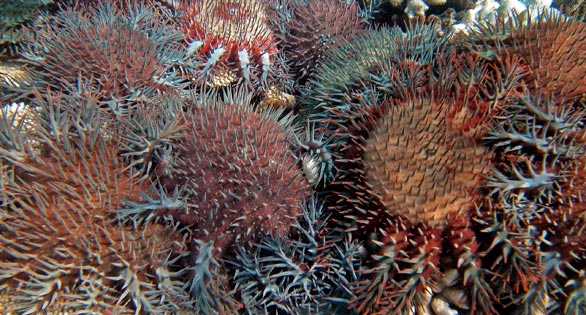
Population outbreaks of the coral eating Crown of Thorns sea stars, Acanthaster planci, have been responsible for 42% of the over 50% decline in coral cover on the Great Barrier Reef between 1985 and 2012. Image: Katharina Fabricius, Australian Institute of Marine Science.
It is the easily one of Earth’s greatest natural wonders and the largest structure built by animals on the planet, but the Great Barrier Reef is disappearing at an alarming rate as its mantle of live coral is disappearing.
A new study by Australian scientists reports that the Great Barrier Reef has lost half its coral cover in the last 27 years. The massive reef is composed of more than 2,900 individual reefs and some 900 islands that stretch more than 1,615 miles (2,600 km). It is described by some as the “largest living organism” and “the largest living thing.”
The loss was due to storm damage (48%), crown of thorns starfish (42%), and bleaching (10%) according to a new study published in the Proceedings of the National Academy of Sciences today by researchers from the Australian Institute of Marine Science (AIMS) in Townsville and the University of Wollongong.
“We can’t stop the storms but, perhaps we can stop the starfish. If we can, then the Reef will have more opportunity to adapt to the challenges of rising sea temperatures and ocean acidification”, says Dr. John Gunn, CEO of AIMS.
Worst Losses in Southern Regions
“This finding is based on the most comprehensive reef monitoring program in the world. The program started broadscale surveillance of more than 100 reefs in 1985 and from 1993 it has incorporated more detailed annual surveys of 47 reefs,” says one of the program’s original creators, Dr Peter Doherty, Research Fellow at AIMS.
“Our researchers have spent more than 2,700 days at sea and we’ve invested in the order of AU $50 million in this monitoring program,” he says.
“The study shows the Reef has lost more than half its coral cover in 27 years. If the trend continued coral cover could halve again by 2022. Interestingly, the pattern of decline varies among regions. In the northern Great Barrier Reef coral cover has remained relatively stable, whereas in the southern regions we see the most dramatic loss of coral, particularly over the last decade when storms have devastated many reefs. ” says Peter Doherty.
The study clearly shows that three factors are overwhelmingly responsible for this loss of coral cover. Intense tropical cyclones have caused massive damage, primarily to reefs in the central and southern parts of the Reef, while population explosions of the coral-consuming Crown-of-thorns starfish have affected coral populations along the length of the Reef. Two severe coral bleaching events have also had major detrimental impacts in northern and central parts of the GBR.
“Our data show that the reefs can regain their coral cover after such disturbances, but recovery takes 10-20 years. At present, the intervals between the disturbances are generally too short for full recovery and that’s causing the long-term losses,” says Dr Hugh Sweatman, one of the study’s authors.
“We can’t stop the storms, and ocean warming (the primary cause of coral bleaching) is one of the critical impacts of the global climate change,” says AIMS CEO, John Gunn. “However, we can act to reduce the impact of crown of thorns,” he says. “The study shows that in the absence of crown of thorns, coral cover would increase at 0.89% per year, so even with losses due to cyclones and bleaching there should be slow recovery.
“We at AIMS will be redoubling our efforts to understand the life cycle of crown of thorns so we can better predict and reduce the periodic population explosions of crown of thorns. It’s already clear that one important factor is water quality, and we plan to explore options for more direct intervention on this native pest.”

Dr. John Gunn responding to Australian Broadcasting Company questions about the state of the Great Barrier Reef. Image: ABC.
“Still Lovely to Visit”
In an interview with the Australian Broadcasting Company, Dr. Gunn said that “the damage to the reef is patchy, with some areas affected more than others.
“There are parts of the reef that are still pretty much as we’d like the whole of the reef to be, and they give us some hope that that’s what we could achieve with the whole of it,” he continued.
“These are areas north of Cooktown and they’re pretty healthy reefs, in fact they’re beautiful.
“It’s the areas that really have these cumulative impacts, the three factors that we take account of in the study that have really come under sort of major pressure.
“But even there, there are reefs that are still very, very lovely to visit.”
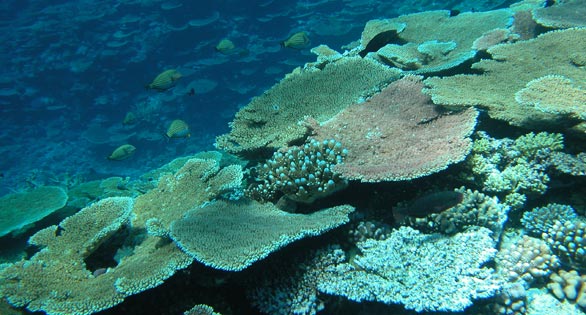
Healthy coral cover at Carter’s Reef, New South Wales, Australia. Image: AIMS Long-term Monitoring Team.
Sources
From materials released by the Australian Institute of Marine Science (AIMS).
http://www.aims.gov.au
www.scienceinpublic.com.au/marine
Proceedings of the National Academy of Sciences
PNAS 2012 109 (40) 15967-15968; doi:10.1073/iti4012109
The 27–year decline of coral cover on the Great Barrier Reef and its causes
Glenn De’ath, Katharina E. Fabricius, Hugh Sweatman, and Marji Puotinen
Edited by Paul G. Falkowski, Rutgers, The State University of New Jersey
May 25, 2012)
ABSTRACT
The world’s coral reefs are being degraded, and the need to reduce local pressures to offset the effects of increasing global pressures is now widely recognized. This study investigates the spatial and temporal dynamics of coral cover, identifies the main drivers of coral mortality, and quantifies the rates of potential recovery of the Great Barrier Reef. Based on the world’s most extensive time series data on reef condition (2,258 surveys of 214 reefs over 1985–2012), we show a major decline in coral cover from 28.0%to 13.8% (0.53%y−1), a loss of 50.7% of initial coral cover. Tropical cyclones, coral predation by Crown-of-thorns starfish (COTS), and coral bleaching accounted for 48%, 42%,and 10%of the respective estimated losses, amounting to 3.38% y−1 mortality rate. Importantly, the relatively pristine northern region showed no overall decline. The estimated rate of increase in coral cover in the absence of cyclones, COTS, and bleaching was 2.85%y−1, demonstrating substantial capacity for recovery of reefs. In the absence of COTS, coral cover would increase at 0.89% y−1, despite ongoing losses due to cyclones and bleaching. Thus, reducing COTS populations, by improving water quality and developing alternative control measures, could prevent further coral decline and improve the outlook for the Great Barrier Reef. Such strategies can, however, only be successful if climatic conditions are stabilized, as losses due to bleaching and cyclones will otherwise increase.
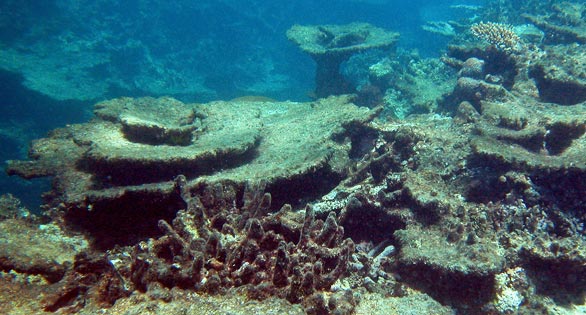
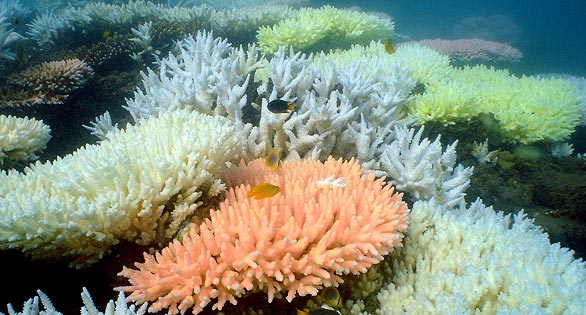

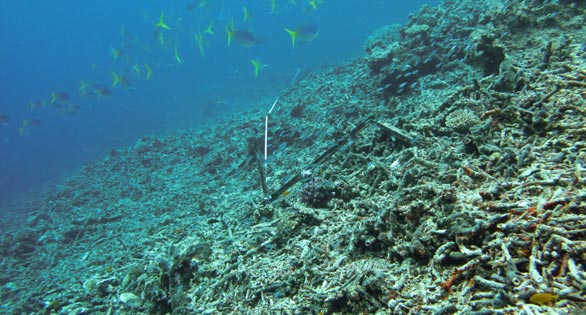





Trackbacks/Pingbacks